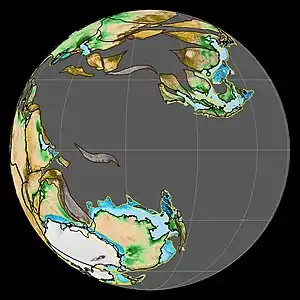Mongol-Okhotsk Ocean
The Mongol-Okhotsk Ocean also known as the Khangai-Khantey Ocean was an ancient ocean, present during the Mesozoic. Oceanic rocks from the ancient ocean floor are preserved in the Mongol-Okhotsk suture zone extending through Mongolia to the Sea of Okhotsk.

Sequence of events
With the formation of the supercontinent Pangea in the mid- to late-Paleozoic, the vast Panthalassa ocean dominated 70 percent of the Earth's surface. The Tethys, Mongol-Okhotsk and various small domains of early Pacific ocean crust constituted other small oceans. Paleomagnetic data collected between 1987 and 2010 suggest that the Mongol-Okhotsk oceanic crust subducted under the terranes of Mongolia in the Late Jurassic or Early Cretaceous.
During the early Mesozoic, the Solonker Ocean, also known as the Intra-Asian Ocean closed bringing together two large continental blocks: Amuria and the North China Block. Amuria then collided with the Siberian Craton, preserving the Mongol-Okhotsk suture zone. Geologists debate why the suture zone ends abruptly near Kazakhstan and have used seismic tomography to develop different interpretations.
Rock formations of the Mongol-Okhotsk suture zone
Most exposed rocks in the suture zone are thrusted accretionary wedges, often with ophiolites. Uranium-lead dating of basalt, dolerite gabbro as well as Silurian radiolarite gives ages constraints on the formation of the oceanic crust. Dated rocks in the Adaatsag ophiolite in the east are among the oldest at 325 million years old. [1] [2]
See also
References
- Van der Voo, van Hinsbergen, Domeier, Spakman, Torsvik (2015). Latest Jurassic-earliest Cretaceous closure of the Mongol-Okhotsk Ocean: A paleomagnetic and seismological-tomographic analysis. Geological Society of America, Special Paper 513. p. 589-92. ISBN 9780813725130.CS1 maint: multiple names: authors list (link)
- Brunet, McCann, Sobel (2017). Geological evolution of Central Asian Basins and the Western Tian Shan Range. The Geological Society, Special Publication 427. p. 29. ISBN 9781862397385.CS1 maint: multiple names: authors list (link)
